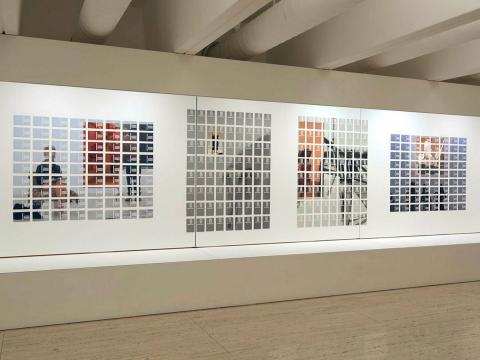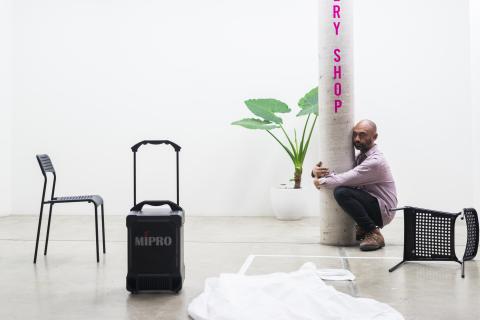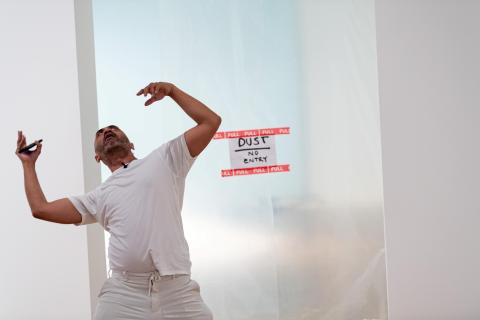Brian Fuata | Artist
By The Last Word
Artlines | 3-2021 | September 2021
| Editor: Stephanie Kennard
Every Artlines issue, we invite an artist, curator or friend of the Gallery to share their practice and passions with us. Here, we spoke with New Zealand-born Samoan–Australian artist Brian Fuata, who is best known for his improvisational performances — and is QAGOMA’s Artist in Residence for ‘The 10th Asia Pacific Triennial of Contemporary Art’ (APT10).
Describe your studio or work area.
I am Artist in Residence at QAGOMA — specifically, the Research Library at GOMA and the QAG Lecture Theatre, and at times hanging out in the Pelican Lounge and Gallery 17, where I’m positioning a work for APT10. How do you know when a work is finished? Quite literally when a timer goes off. I set a timer as part of the performance: wherever the audience and I are when the alarm rings is when the performance ends.
What is your most important tool as an artist?
The access and capacity for poetry I think is both a practical and soulful tool for the whole world.
What, if anything, gets in the way of making art?
I used to think doubt was creative because I aligned it with humility or something — the act of ‘second-guessing’ seemed productive in that it suggested more options. I’ve only recently come to know that doubt is useless and destructive.
Do habits help or hinder creativity?
Habits of awareness and openness alchemise seemingly disparate things. Awareness and openness transform doubt.

Brian Fuata / IWMLDFS (or mini-bar) 2018 / Taken during a live performance at the Institute of Modern Art, Brisbane / Image courtesy: The artist / Photograph: Louis Lim
What do you do when you’re not feeling inspired?
Certain pressures/states/conditions across artistic, institutional, financial and social contexts, both naturally occurring and constructed, induce an outcome. Productive exercises, games or projects often enable that. I have a correspondence–performance project called Call and Response (changing title: 2010 to now) where I invite a person to send a digital text. I have 24 hours to respond. The writer and I to and fro for a calendar month — and then it simply ends, like the timer in my ghost improvisations. Since 2010, I’ve amassed an exquisite corpus of text and images that both the writer and I can refer to, either jointly or separately, to make content. There's no public outcome, it's just between the writer–performer and me. Most importantly, this project has forged deep connections (and some electric disconnections) with people around the world, which is, in itself, inspiring and inspired. Correspondent artists include Hana Pera- Aoake (Aotearoa), Sid M Duenas (Guam/US), Mitch Cumming (Aus) Dan Taulapapa McMullin (Eastern Samoa/US), Ainslie Templeton (Aus), Benny Nemerofksy Ramsay (Canada/France) and Tony Schwensen (Aus/US). I can truly say we fell in love with each other.
How often do you visit art galleries or museums?
I visit artist-run, uni, state and city places often. I like art shows, though I often procrastinate on seeing them.
What’s the last gallery or exhibition you went to? What did you like (or not like) about it?
Angela Goh's 'Sky Blue Mythic' with sound by Corin Lleto is a dance work where Ange's body feels alienated from its humanity. Set in an entirely white stage and moving only on frontal and diagonal planes, Ange uncannily embodies a digital representation of choreographic movement, e.g., balletic phrasing is accompanied by one eye rapidly blinking, or a backbend while staring directly at the audience diagonally backgrounds a tipped can of orange energy drink. It's strangely emotive with its stark minimalism. It's also physically virtuosic. The work is wild. Where did you grow up, and how do you think this has influenced your practice? Woodridge, then Kingston in Logan City — in a Samoan Catholic family with a devout unionist Dad. It influences me as a person a lot.
What is your most treasured possession?
A ceramic ghost figurine that dear artist-friends Dom and Dan Angeloro got me from an op shop.
FUATA, Brian
1978
- present
Full profile
for FUATA, Brian

Errantucation (mist opportunities) 2021
- FUATA, Brian - Artist
- VIRAG, Jeremy - Camera
- AQUILIZAN, Diego - Camera
- McGUIGAN, Matthew - Post-production
- RYAN, Denny - Producer and camera

Found Projector Props (from 'Errantucation (mist opportunities)') 2021
- FUATA, Brian - Artist
- DOREY, Nick - Artist midwife



